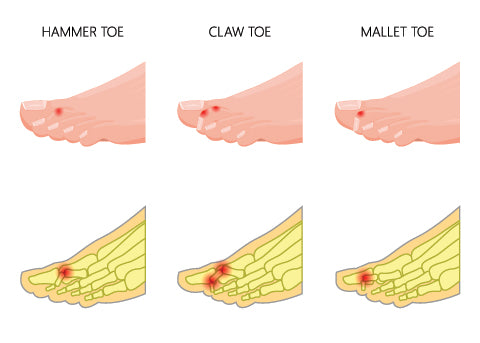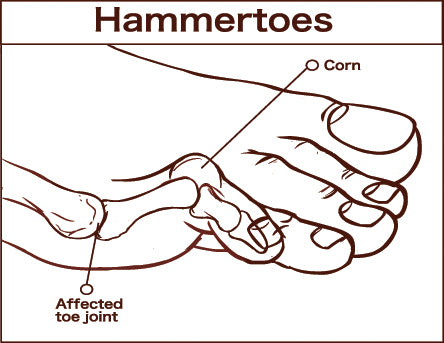Hammer Toe
Complaining of a Crooked or Bent Toe?
A hammer toe is an abnormal bending of one or both joints of the second, third, fourth, or fifth toe. The bending is the result of a weakened muscle in the toe.
In the early stages, the toe can still be moved at the joint and is called a flexible hammertoe. It becomes a rigid hammertoe if the tendons press the joint out of alignment and the toe can no longer be moved.
Other similarities to this condition include a mallet toe and a claw toe. In each of these conditions, a different joint is contracted.

A hammer toe, claw toe, and mallet toe are all the result of a contracted joint. Treatment is similar for all three, and a doctor will be able to recommend prevention and care.
What Is Hammer Toe?
A hammer toe is one of the most common deformities of the foot.
The visual effect gives off the appearance of a toe hammering the ground – the PIP joint protrudes upward and the tip of the toe is flat on the ground. The deformity usually occurs in the second toe and is often related to the length of that toe.
The condition may also cause metatarsalgia at the base of the second toe. The biggest complaint with a hammer toe is usually friction in the shoe due to the toe rubbing on the upper area of the toe box. This irritation can cause callus formation, especially on the tip of the joint protruding upward.

A hammertoe will often cause irritation or a corn to develop on the top of the protruding joint. The condition can also cause difficulty walking or painful gait.
What Does Hammer Toe Feel Like?
Hammer toe is a deformity of the foot, symptoms of hammer toe include the following:
- Pain or discomfort in the top part of the bent toe.
- Corns and calluses from increased friction between the toe and shoe.
- Inflammation and redness from persistent friction or pressure.
- Restricted movement of the toe, advanced cases can result in rigid toes that resist flexing.
- Joint stiffness. Over time, affected toe joints can become stiff and painful.
What Causes Hammer Toe?
Oftentimes a hammer toe is genetic and the chances of developing the condition increase as you age.
It can also be caused by wearing tight-fitting shoes or shoes that are too short. Those who take special care to wear shoes that are not too short or too tight in the toe box decrease their chances of developing a hammer toe.
There are also certain medical conditions that can cause a hammer toe to develop. These conditions, such as inflammatory arthritis, affect the joints and cause contracture.
How to Treat Hammer Toe?
There are a variety of treatments available for hammer toe as you may be able to treat this condition at home before opting for surgery.
Change your footwear
Changing your footwear is the first thing to try if you find that you have hammer toe. Opt for shoes with a deep toe box that don’t squeeze your toes. This will reduce pressure on the deformed toe and can prevent further progression of the deformity.
Try orthotics
If changing your shoes does not work, try adding more support via toe pads or custom orthotics. These can provide more support, add cushioning, and reduce pain from this condition while wearing shoes. Orthotics can help to redistribute pressure evenly helping you walk pain-free.
Exercise/Physical therapy
There are exercises you can try, though these will be more helpful in the early stages. Toe curls/scrunches and toe stretches can strengthen the toe and improve flexibility. Remember to take anti-inflammatory medication as well to manage pain in-between sessions.
Surgery
If the above home remedies do not work, then surgery may be required. This could include treatment to reroute the tendons in the foot or correct issues should the bones in the toe be fused together.
What to look for in insoles for hammer toe?
If you are looking for insoles to either ease the pain from hammer toe or help treat it, here are a few things to consider:
- Deep Toe Box: Look for insoles that can accommodate or complement a shoe with a deep toe box. This ensures there's enough room for the toes, reducing the pressure and friction on the hammer toe
- Arch Support: Proper arch support can ensure the even distribution of weight across the foot. This is crucial for preventing and alleviating symptoms related to hammer toe and other foot conditions.
- Material and Cushioning: Choose insoles made from materials that offer a combination of cushioning and support. Materials like memory foam, gel, or EVA can provide relief from pressure points.
- Fit and Slim Profile: Insoles should fit comfortably inside your shoe without making them too tight. A slim profile is especially important for those with hammer toe to ensure there's still adequate space for the toes.
